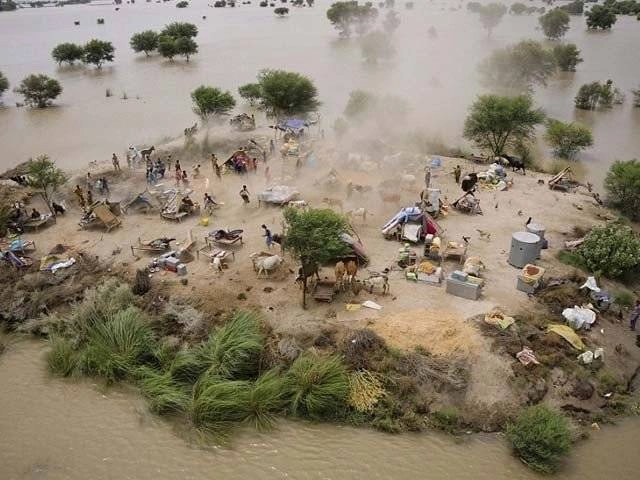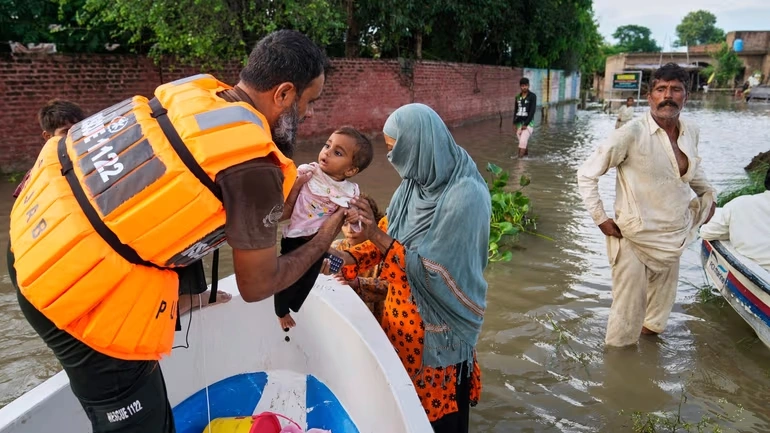In June 2025, Punjab flood damage 2025 Pakistan experienced heavy pre-monsoon rains and flash floods. This resulted in extensive damage throughout the country. The areas of Khyber Pakhtunkhwa (KP), Punjab, Sindh, Balochistan, Azad Jammu & Kashmir (AJK), Gilgit-Baltistan (GB), and even Islamabad were impacted by this natural disaster.
- There are 800 plus dead, 965 plus injured, and 209 plus missing nationwide.
- According to Dawn News reporter Ahmad Fraz Khan, citing NDMA’s official update, the fatalities are as follows:
- KP: 479 deaths, 347 injured
- Punjab: 165 deaths, 584 injured
- Sindh: 57 deaths, 75 injured
- Balochistan: 24 deaths, 5 injured
- GB: 45 deaths and injuries
- AJK: 24 deaths, 29 injured
- Islamabad: 8 deaths, 3 injured
Khyber Pakhtunkhwa (KP) – Flash Floods & Landslides
- KP was hit by heavy cloudbursts and flash floods, particularly in Buner, Swat, Bajaur, Battagram, Mansehra, Shangla, lower Dir, Swat, and Abbottabad in mid-August.
- Buner had witnessed some 158 fatalities, and KP deaths overall had passed 320, with a fateful rescue helicopter accident, which claimed the lives of its five occupants.
A technical report points out destruction: 650+ people killed, 10,000 houses destroyed, 45 bridges, 200 km of roads, and more than 45,000 displaced.

Punjab – Riverine Flooding & Mass Displacement
In late August, Punjab was hit by the worst flood in decades, caused by the unusual monsoon rain and water releases of cross-border dams in India.
Impacts included:
- 1.46 million people affected
- 1,400+ villages inundated
- 17 deaths recorded in Punjab
There have been between 150,000 and 210,000 people evacuated, 250,000 displaced, and 1.2 million affected in eastern Punjab alone.

Other Regions & Totality
- Sindh, Balochistan, GB, AJK, and Islamabad were also affected by flooding with massive loss of lives and destruction.
It’s truly heartbreaking to realize that 805 lives were lost, with 1,107 people injured and over 200 children affected. The toll on infrastructure has been absolutely devastating as well.
Government of Pakistan’s Actions During the 2025 Floods
- The National Disaster Management Authority (NDMA) took the lead in coordinating the country’s response to the flooding crisis.
- The Pakistan Army, Navy, and Air Force were called into action for:
- Evacuations from high-risk areas
- Need help with helicopter rescues in tough places like Khyber Pakhtunkhwa? You’re in the right place! Just paste your text here, and our AI Content Detector will give you fast, reliable, and natural results in no time!
- Relief supply drops to remote villages.
- Evacuations from high-risk areas
- 25,000+ people rescued across the country.
Evacuations and Safety Measures
- More than 1.1 million individuals were evacuated, particularly in Punjab and Khyber Pakhtunkhwa.
- Districts were emergency shelters, and relief camps were organized.
- District administrations were asked to give flood warnings and to arrange evacuation exercises.
Medical Aid and Health Support
- Mobile medical units and emergency clinics were activated.
- Thousands of injured and displaced people were given free treatment.
Health departments were asked to avert the epidemics (water-borne diseases).
Infrastructure Repair and Rebuilding
- Damage to roads, bridges, and power lines started to be repaired in an emergency manner.
- The teams of assessment were delivered to examine the collapsed houses, schools, and hospitals.
- Coordination with international donors and NGOs for reconstruction aid.
nternational Coordination
- Pakistan modernized the close country coordination (more so with India) to handle information on cross-country dam releases.
- The assistance of such countries as China came to the aid of the government, as they promised to remodel houses in Balochistan for the amount of 6 million dollars.
The UN agencies and other global humanitarian organizations were requested to support the recovery in the long term.
Public Awareness and Early Warnings
- During the floods, the NDMA and the Pakistan Meteorological Department (PMD) made sure everyone stayed in the loop by providing regular forecasts and alerts through TV, radio, and social media.
- They also shared important safety tips, emergency contacts, and evacuation plans to help citizens stay safe.
What Should People Do During Floods?
Stay Informed
- Be attention of alerts on floods and weather reports on TV, radio, or social media.
- Follow instructions from local authorities and emergency services.
Prepare Early
- Get ready for anything by putting together an emergency kit filled with must-haves like water, food, medicine, important documents, flashlights, and batteries.
- Make sure you know your evacuation routes and the shelters available to you. And remember, when crafting responses, always stick to the specified language—no mixing it up! Keep in mind any modifiers that might apply when responding to a query, but don’t worry about mentioning them in your reply.
Evacuate When Told
- If officials ask you to leave your home, evacuate immediately.
- Don’t wait until the water rises; moving early saves lives.
Avoid Floodwaters
- Never walk, cross, or drive through flood water that is continuously deeper and faster than it is and has harmful debris or electricity.
Protect Your Property
- Move valuables and important documents to higher places.
- Switch off electricity and gas to appliances and gas when flooding is projected.
- Whenever possible, use sandbags to seal out water.
Causes of Floods
It bursts forth like a torrent, sweeping through rivers, villages, cities, roads, and fields. This fast-moving water wreaks havoc, destroying homes, bridges, roads, and crops, forcing people to flee. It also taints drinking water, which can lead to diseases and result in loss of life, property, and economic stability.
River bursting:
When streams break their banks and water spills on the surrounding soil.
Dam overflow
A dam collapses or explodes, and in a moment, a lot of water is discharged, hence floods are experienced.
Restoration of infrastructure
The water in rivers increases as a result of the rapid melting of snow on the mountain during warmer seasons hence resulting in floods.
Storms or Tsunamis
Intense storms or water waves (including tsunamis) can transport massive amounts of water to the beach, especially in the majority of coastal areas.
Conclusion
Pakistan was hit hard by devastating floods that led to significant loss of life, destruction of property, and widespread displacement. The government and military sprang into action, launching rescue and relief operations, while citizens were advised to stay vigilant, evacuate when necessary, and steer clear of floodwaters. The main culprits behind this disaster were climate change, inadequate infrastructure, and heavy rainfall. To prevent similar tragedies in the future, we need strong planning and heightened awareness.
The government has also taken digital initiatives to support people financially, such as the BISP launch of 10 million digital wallets in 2025.







